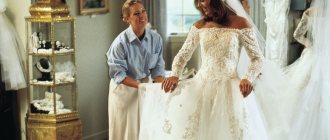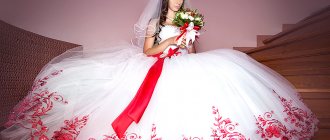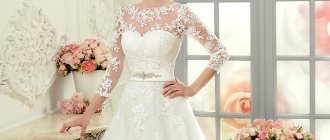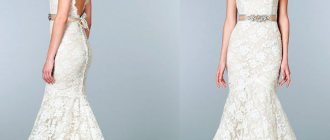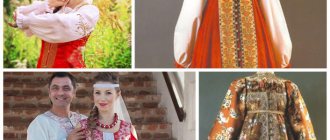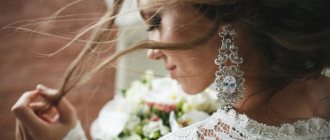Kazakh wedding dress. History of the costume, meaning and modern options
09/28/2015, 09:32 Modified: 08/21/2021, 23:45
Before the wedding, Kazakh women have a good opportunity to shine in two dresses. It is traditional to wear a national dress for Uzatu (seeing off the bride). It turned out that not all girls dream of a dress from Vera Wang or Elie Saab. This is evidenced by the popularity of ateliers that accept orders for Kazakh wedding dresses.
By the way, before putting on that same dress, you should understand the sacred meaning of this robe and look at photographs from antiquity and compare modern options.
You probably noticed that the original appearance of the Kazakh dress is different from today’s version. In the original, the dress was not so bright, and there were not so many patterns. But in terms of the “richness” of the outfit, this version was superior to the current one, since the stones on the saukele were precious.
“The Kazakhs wore such a headdress for about a year before the girl’s marriage. The richer the father was, the more richly the saukele was decorated. At the very top, in a place called taj (I suspect from the Arabic word “taj” - translated as “crown”), precious stones, pearls, corals, gold and silver coins were sewn on. In addition, it was decorated with gold threads, brocade and velvet. A “zhaktau” trimmed with fur and precious stones was sewn along the edges. and the ends of the zhaktau were tucked into pockets sewn to the bride’s dress. So that they do not break under the weight of decorations. In a word, saukele was a symbol of family well-being. Something like a business card." (Aizhan Hamit)
It is also worth noting that there are speculations that the long sleeves of the shapan meant that the girl was from a rich family and was not burdened with household chores.
“The Kazakh wedding headdress saukele is 100% borrowed from the Sakas, for whom the pointed high cap served as the “crown” of the ruling elite.” (From the facebook group “National Clothes Day”)
Below are the basic attributes of wedding clothing:
Kosetek is a light dress with frills, cut 5-6 cm below the waist and very fitted. A wide flounce was sewn to the skirt of the dress, onto which several rows of gathered frills were sewn - zhelbezek . Frills also decorated the bottom of long sleeves and the collar. In some areas, instead of a frill, they made two or three folds. chikoilek undershirt , which was usually made of white material, with narrow sleeveless shoulders and a collar neckline tied with ribbons.
Camisole - outerwear , was sewn mainly from brightly colored velvet. Its length was below the hips, the silhouette was fitted, usually lined. The neckline, floors and bottom of the camisole were decorated. Most often it was embroidery: satin stitch, vestibule, gold and silver thread, or border, lurex stripes, braid or beads.
Saukele consisted of two parts. A conical cap made of fabric, quilted, with a lining, up to 25 centimeters high, was placed directly on the head. Sometimes a forehead and back pad were sewn to it. The saukele was worn directly over it. The material for this beautiful and ceremonial dress was thin felt, trimmed with bright, most often red, fabric. The back of the cone was 10 cm higher than the front. There is a hole at the top. From below, and sometimes in the middle, the saukele was trimmed with fur. The front part was decorated with all kinds of stripes: braid, corals, beads, silver plaques, precious stones. Long pendants made of threads of coral, turquoise, silver plates, and silk tassels that reached the waist were attached to the sides.
A mandatory addition to the saukele is a cape - zhelek - made of light fabric. Most often it was attached to the top of the saukele. Such a cape could cover the entire figure. In the old days, special bedspreads were sewn for this purpose from white silk, muslin, and decorated with embroidery. As a rule, the saukele was inherited, and from the attire of a young married woman it turned into a wedding headdress.
From the Internet, I have collected the most beautiful modern versions of Kazakh wedding dresses. Let's watch and be inspired!
What is unique about the national wedding dress?
National wedding dresses are original and unique - they are not just elegant clothes, but an important part of folk culture. The design of traditional wedding dresses contains important information about the affiliation and social status of the bride. As a rule, the patterns and symbols decorating such a wedding dress have always had a certain meaning.
For some nationalities, one could immediately understand from the style and design of the wedding dress:
- what family does the bride belong to;
- find out about the wealth of her family;
- ethnicity of the newlywed.
A lot of painstaking work was put into making a wedding dress, because almost every element was done by hand and was a very labor-intensive process. Sometimes wedding dresses were passed down from generation to generation. An excellent example of a wedding dress in the national style is the outfit of a bride from Kazakhstan.
History of Kazakh costume
Aspects of the Kazakh national costume were born from the history of the Turko-Mongol tribes. Each element of such an outfit has a historical justification, determined by the climate, the way of life of the Kazakhs, living conditions and moral principles.
National clothing reflects the status of the person wearing it. According to their purpose, Kazakh costumes were divided into festive, casual, rain, outerwear, and underwear.
According to ancient customs, warriors wore their best and most expensive clothes before battle. Rich fabrics were used to sew festive outfits.
Kazakh clothes were made from silk, wool, felt, and animal skins obtained from hunting.
Velvet, brocade, velor, satin and corduroy were also familiar to the Kazakhs, but were used less frequently. Sheepskin coats and fur coats were common in Kazakhstan long before they appeared among other nations. Men's and women's trousers were made from luxurious fabrics; simple natural materials were rarely used.
Women's Kazakh outfits
Women's clothing differed from men's costumes in a wide variety of colors, embroidery, intricate patterns and, of course, such an element as a dress.
Women's underwear included cossacks, trousers, vests, and dresses. Chapan and buy were outerwear. Buy sewn on a fur lining.
Women's festive skirts were made with numerous frills. Girls wore robes with clasps; married women were allowed to wear suits without clasps with a belt.
Description of the Kazakh national wedding dress
A bridesmaid dress in the Kazakh style is a unique example that allows you to understand the fabulous beauty of oriental wedding dresses.
KNOWLEDGE BASE: French style wedding dress: elegant femininity
The fashion for white wedding dresses came to Kazakhstan relatively recently and it appeared as a result of a mixture of different cultures. Initially, the dress was sewn in the color that was the color of the bride’s family and it could be any color - red, blue and even black. Black color in the East has always symbolized greatness and power, but white was considered the color of mourning and sadness. But modern life has made its own adjustments, and a white bride’s dress in Kazakhstan can now be seen quite often.
The wedding dress of the Kazakh bride is a model made of light material with a slightly low waist. Ruffles are sewn onto his skirt in several rows, which give it a fluffy look. The sleeves of the dress are long and wide - in the old days it was believed that the longer the sleeves, the wealthier the bride’s family. An undershirt made of thin white material without sleeves is worn under the dress.
Over the dress is worn a fitted camisole, made of bright velvet, decorated with gold or silver embroidery in the form of national ornaments. Beads, canvas, and coins are also widely used for decoration. And, of course, all kinds of jewelry in the form of bracelets, rings, and pendants are required. Photo of a Kazakh bride’s wedding dress:
KNOWLEDGE BASE: Everything about wedding dress styles
Features of the Kazakh costume
National clothing in Kazakhstan has the following features:
- Bird feathers, fur, lurex, and down were used to decorate the costume;
- Most clothing items had a fitted silhouette;
- Everyday clothes were decorated as richly as festive ones. The difference between clothing for the celebration was more voluminous decoration and more decor;
- The swing cut was present on both outer and underwear;
- Tall headdresses were decorated with fur and gold embroidery. Men also wore high caps made of light and light fabrics;
- Robes (shapans) were not only worn by the Kazakhs themselves, but also given to dear guests of any religion.
The costume of a Kazakh or Kazakh woman had to be as comfortable as possible, so that it would be easy to ride a horse, cook dinner and look after children.
The original beauty of national wedding dresses
The creation of a new married couple, in its essence, is a continuation of the family and a guarantee that the history of a given people will continue for many centuries. That is why in any country a wedding is a great holiday. The variety of national wedding dresses is striking in its beauty and knows no bounds.
For example, a Russian wedding dress in the national style was a work of folk art and was passed down from generation to generation. The wedding outfit of a Russian bride consists of a shirt decorated with folk ornaments embroidered by the bride herself and a long sundress made of brightly colored material, which also served as proof of her skill. Depending on the wealth of the bride's family, the outfit was decorated with precious stones and furs. The Russian bride's head was crowned with a beautiful kokoshnik, and ribbons were woven into her braids.
KNOWLEDGE BASE: Arabic style wedding dresses: style and design
If you look at the outfit of a Belarusian bride, you can also pay attention to the abundance of embroidery in folk style and handmade lace.
And how beautiful are the wedding dresses of beauties from Ossetia! The unique national flavor gives the bride elegance and grace. Despite the maximum closeness of the outfit, thanks to the fitted simple cut and traditional decorations, the bride in such a dress looks majestic and noble.
From all this, only one conclusion can be drawn: true beauty is stronger than time, and even after many years, the theme of traditional dresses, as before, is relevant and in demand.



